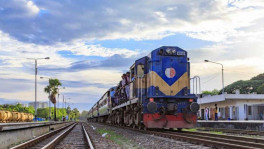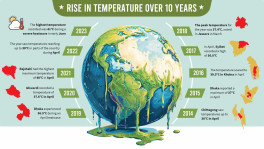Bangladesh's response to Covid-19: mid-April standings
The spirit of hoping for the best while preparing for the worst may be the best possible guiding principle in dealing with this evolving situation

The novel coronavirus is on an infection spree through social milieus, having graduated from the individual contact phase, as indicated by the Minister of Health in his electronic briefing the other day.
In fact, the number of Covid-19 cases in the country has been rising steeply over the past few days. The total number affected rose to 1,572 and deaths to 60 as of 17April.
At this stage, there is no way of knowing how long the pandemic will continue, how many people will be affected and how many unfortunate deaths will occur.
However, from the management point of view, it would certainly be wise, under the prevailing conditions of uncertainties, to err on the side of overestimation. That is, it may be assumed that the virus's unbridled run will continue for up to eight weeks or more from now – if China, the worst-affected European countries and the USA are any guide.
However, whether the time period will be longer or shorter will critically depend on the efficacy of the containment efforts being pursued. The spirit of hoping for the best while preparing for the worst may be the best possible guiding principle in dealing with this evolving situation surrounded by uncertainty.
Bangladesh has been mounting major efforts for novel coronavirus-related awareness-building and persuading people to socially and physically distance themselves – starting in mid-March but more purposefully from 25 March.
A general leave from work at offices, and other workplaces, was declared and people were called upon to stay at home and observe the do's and don'ts for Covid-19 avoidance. Also, restrictions were put on the movement of people locally, nationwide and internationally.
The belt was gradually tightened using the police and army. However, a large number of people are not cooperating. One group with many noncompliant members is the returnee expatriates from countries worst-affected by Covid-19, and that contributed to the spread of the virus in the country. However, a major proportion of the people who go out are probably unable to stay at home if only to try to find some way to earn a little and buy some food to keep their bodies and souls together.
They include: the ultra poor, marginalised farmers, farm workers, day labourers, fishermen, rickshaw and van pullers, building workers, hotel workers, newspaper hawkers, cottage and micro enterprise owners, plus low-income employees in private sectors and rural and urban informal sectors, who have lost their jobs.
They are the principal candidates for relief support in terms of food items and other essential consumer necessities. Relief for them is obviously their lifeline. Even if they wanted, there is simply no opportunity for them to earn a living for most of them.
The government has been taking measures to manage the pandemic and the trail of devastation it may leave behind in relation to health and economic conditions.
Prime Minister Sheikh Hasina announced an assistance and stimulus package of Tk 72,750 crore – 2.52 percent of GDP – on 5 April 2020. It was followed up with an additional package on 13 April 2020, raising the total financial package to Tk 95,619 crore – 3.3 percent of GDP. It appears that the loan of Tk 5,000 crore announced earlier – for salaries and wages to be paid to workers – is not included in the total amount announced on 13 April.
Regardless, the package reflects a bold gesture. Clearly, the Prime Minister is leading from the front, with a strong feel for the causes of the people, particularly of the soaring numbers of marginalised people in the wake of the coronavirus pandemic.
This pandemic has occurred in Bangladesh, along with the whole world, at a time when this country had been making great strides in relation to economic and social progress and had been poised to consolidate its achievements plus accelerate towards take-off. Unfortunately, both the internal and external circumstances of any country, and surely of Bangladesh, are turning out to be increasingly adverse. For example, on the external front, a large number of Bangladeshi expatriate workers have lost their jobs and the prospects of them getting their jobs again anytime soon seems bleak.
As a result, Bangladesh's incoming remittance regime is already jolted and the prospects of recovery are uncertain, to say the least. The country's exports have already been suffering greatly and the recovery trajectory cannot be predicted at this stage with any certainty. Worse still, a major global recession is clearly in the offing.
The IMF has predicted that the global economy will shrink by three percent in 2020. It will be a torturous road to traverse for the global economy and for individual country economies to recover and move on to rejuvenation. For Bangladesh, it remains to be seen how long the pandemic will last in the country – and also internationally – as well as the havoc it will play on Bangladesh's economic and social dimensions.
Bangladesh's significant advancements in recent years has been possible largely as a result of a conducive policy environment put in place by the government. The public has responded to the opportunities thus created by their urge to move forward matched by their efforts to do so.
A Gallup poll, taken in 2015, found that Bangladeshis are the most hopeful people in the world, ahead of China. The opinion expressed by Bangladeshis is reflective of the visible progress they made and their expectation of a brighter future.
The achievements could have been larger, though, had it not been for the marauding groups of cronies and self-aggrandisers. Anyway, can that synergy be re-enacted once this raging pandemic has been defeated? If yes, how long will it take to do so?
In this journey, the first priority is to save lives as Covid-19 ravages people and devastates economic and social fabrics. The groups of people who will be at the forefront of adversity have been mentioned earlier. Every country, including Bangladesh, engages in saving lives – as the pandemic afflicts their societies to varying degrees.
In order to save people from the virus – apart from the requirement that people maintain social and physical distancing and observe the do's and don'ts in order to keep the virus at bay – it is a top priority of the government to take appropriate measures including extensive and intensive: testing, isolating, tracing, and treating.
Of course, facilities for these actions need to be created adequately, which encompasses testing kits; hospital beds – including isolation and ICU units; plus personal protection equipment (PPE) for doctors, nurses and other health workers as well as numbers of these frontline health personnel. The Government of Bangladesh is now assigning high priority to this task and all the facilities have so far been expanded significantly.
However, there are still gaps which should be assessed to the extent possible in relation to the likely peaking of infections in the country. Accordingly, action should be strengthened towards fulfilling the targets. But, it is easier said than done.
Even the USA and UK are struggling with this. However, we should try our best, with honesty and speed. It is encouraging that the private sector hospitals are coming forward to add their efforts to the government's.
To save the above-mentioned marginalised millions from starvation, the Government of Bangladesh has mounted relief efforts by expanding social safety nets – providing food and other essential consumer necessities – and other measures. However, given the huge numbers of people targeted to serve – spread all across the country – it is not possible for the government alone to accomplish the huge task.
The good news is that private sector organisations and resourceful people are also joining forces to help the Covid-19-devastated people. Yet, much more can come from them – which I hope will be forthcoming as Bangalees rise to the occasion when disasters strike.
It is vital that all relief and assistance efforts be properly coordinated to provide for those who need to receive the support. There is no room for corruption in government relief distribution and self-aggrandisement in the private efforts. All violators must be meted out exemplary punishment.
The next urgent issue is to keep the economy moving. Let us look at the assistance and stimulus package Prime Minister Sheikh Hasina announced on 5 and 13 April. Surely, more will come if the changing circumstances demand, but, even as of now, the package is substantial.
One particularly good decision is to provide financial and insurance support to all health caregivers during the pandemic. This allocates doctors, nurses and all other health assistants Tk.850 crore – 0.9% of the total package. There is however no allocation in this package for expanding health facilities and health-related human capacity.
How much the economy will be affected cannot be properly assessed now. The duration of the pandemic and the devastation caused by it will say where we stand and how the recovery phase should be constructed. However, the World Bank has projected Bangladesh's GDP growth prospects as two to three percent in 2020, as 1.2 to 2.9 percent in 2021, and as 2.8 to 3.9 percent in 2022.
Certainly, there will be economic slowdown in Bangladesh, as well as elsewhere, but these World Bank figures need not agitate our minds and we should refrain from spending time debating Bangladesh's growth prospects, taking the World Bank projections as the point of departure.
What is important is to make our best efforts to keep the economy moving and rejuvenated in the course of time. In this context, the package announced by the Prime Minister is a very encouraging start.
It includes four broad action programmes to be implemented over short, medium, and longer terms: (a) an increase in government spending with focus on employment generation; (b) extended support programmes focusing on rejuvenating economic activities, keeping workers in their jobs, and maintaining production capacity; (c) the expansion of social safety nets to support marginalised groups with relief; and (d) the expansion of money supply, remaining vigilant to keep inflation under control.
The package, as announced on 13 April, amounts to Tk 95,619 crore. It includes:
- A safety nets expansion package of Tk.6,859 crore, for both rural and urban areas, accounting for 6.75 percent of the total allocation.
- For affected large manufacturing and service industries: a working capital loan fund, at an effective interest rate of 4.5 percent, in the amount of Tk 30,000 crore; an additional export promotion fund of Tk 12,750 crore; pre-shipment credit refinancing of Tk 5,000 crore; and a special fund for export-oriented industries worth Tk 5,000 crore. The total amount is Tk 52,750 crore – accounting for well over half the total allocation at 55.2 percent.
- For cottage, micro, small and medium enterprises, an allocation of Tk 20,000 crore as working capital support at an effective interest rate of four percent. The share of the total allocation is 20.9 percent.
- For food and agriculture, support covers: government procurement of rice in the forthcoming seasons, up to Tk 860 crore; the purchase of agricultural tools, implements and machines, totalling Tk 200 crore; working capital support to small and medium enterprise farmers – engaged in crop, vegetable, fish, dairy and poultry production – amounting to Tk. 5,000 crore at four percent interest; plus an agricultural subsidy of Tk.9,500 crore. The total is Tk 15,560 crore, 16.3 percent of the total.
One may raise issues with the relative sectoral allocations. However, as implementation progresses, review-based adjustments will surely be possible – adding new allocations if genuinely needed. However, no allocation, in the package, for medical capacity-building is rather surprising.
The question that comes to the fore relates to the implementation of the package. Coordination, commitment, speed, and efficiency are the key concepts here. In all these respects, there are question marks.
Attention must be given to overcoming whatever deficiencies there are, through political and administrative action. No negligence or dithering at any level should be tolerated. It is an extraordinary time and we must rise to the occasion in an extraordinary fashion.
Policy guidelines and urgency of action – embodied in the assistance and stimulus package – must be effectively followed through in designing implementation procedures as well as identifying the people to be saved and industries and businesses to be assisted. An assessment of their needs must be undertaken as quickly as possible.
The task of delivery is relatively easy for large and export-oriented industries. They are organised and can articulate their needs plus raise their voices so that this part of the package is implemented relatively easily. Small and medium enterprises also belong to the organised segment of the economy and should not be very difficult to reach through the banking system – given a purposeful approach.
The implementation of the safety net activities is difficult because of the huge numbers of people involved – dispersed in rural and urban areas across the country. They are atomised and not in a position to inform officials, and others in charge of relief and assistance distribution, of their need for assistance. So, the burden is on the government, central and local, and other distribution infrastructures to find the intended beneficiaries and properly deliver the goods and services to them.
The same is true of the large numbers of cottage and micro enterprises, spread across rural and urban areas of the country. Often, they are not banked and also not attractive clients of banks because of their low financial operations. It is not easy to identify and reach them. Local governments can be helpful in reaching both safety net beneficiaries and cottage and micro enterprises.
However, local governments do not have either the expertise or capacity to carry out these responsibilities. The large number of non-governmental organisations (NGOs) which deal with most of these enterprises can be enlisted in this effort.
The Palli Karma-Sahayak Foundation (PKSF), which is a government-sponsored foundation, works with most medium and larger-sized NGOs. If given the responsibility under appropriate arrangements, it can play an effective management and coordinating role in the process of mobilizing NGOs and strictly monitoring their operations.
In this concluding section, while welcoming the assistance and stimulus package launched by the Prime Minister, let me flag some of the important issues and challenges that need to be addressed even as the fight against Covid-19 continues:
- Dengue season is almost upon us. If Dengue also breaks out, the situation will be much more complicated and dangerous. We must be on our guard, with our hands on preparations to meet that eventuality if it occurs.
- The season of destructive weather behaviour is beginning. If a cyclone or a flash flood were to occur, there will be additional dimensions to the turmoil we are in, demanding action and resources. A contingency plan must be prepared, which will certainly come in handy should such a situation arise.
- Tax collection is very low as it is, as a proportion of GDP, and it may suffer a setback under the prevailing and developing circumstances, spelling a much more difficult fiscal regime. It would be prudent to make a contingency plan to stem that from happening and manage the shortfall if that happens as purposefully as possible – given relief, rehabilitation and rejuvenation needs on one hand and the on-going development programmes on the other.
- In the relief and assistance programmes being implemented, everybody, everywhere from among all segments of the population, who are in need of such support, should and can be reached by identifying them through coordinated efforts at central and local levels. Although in a country of over 165 million people, it is a formidable task to identify and reach all of them, every citizen is entitled to protection and support – particularly in the wake of a pandemic. Here, an all-out centrally and locally coordinated and transparent mechanism should do the trick.
- One important lesson to be learnt from the Covid-19 pandemic is that our health service infrastructure, and delivery of health services, is weak – and the annual budgetary allocation of only about one percent of GDP is grossly inadequate. It behooves policymakers to seriously rethink this issue with a view to significantly raising the annual allocation.
- A planning exercise needs to be carried out using the framework contained in the Prime Minister's statement while announcing the relief and assistance package on 13 April. It should flesh out policy and action programmes, with timelines and budget requirements in relation to rehabilitation in the short term; rejuvenation in the short and medium terms; plus sustained progress in the medium and long terms. Such an exercise may already be in the works, as indicated by the prime minister. The issues of inclusive and equitable development and environmental protection and enhancement, underlying the Agenda 2030 for sustainable development, must be kept in perspective in this exercise.
- In order to rejuvenate the synergy between people and the overall policy environment – that has been such an effective factor behind Bangladesh's celebrated forward march over the past decade or so – people-centred approaches and action programmes backed by appropriate policies and resource allocations need to be pursued. One noteworthy example of such an action is the plan to provide houses for the homeless during Mujib-Year, for which Tk 2,130 crore has been allocated. Indeed, the approach has to be broad-based. A focus on skill training for employment and setting up cottage, micro and small enterprises – implemented to an extent – needs to be widened in scope and strengthened.
- Bangladesh Bank has, in the meantime, reduced cash reserve requirements (CRR) to four percent – from five percent – on a weekly average basis, and to 3.5 percent – from 4.5 percent – on a daily basis. REPO has been reduced to 5.25 percent from 5.75 percent. As a result, cash available with banks should increase. Further actions to increase money supply may be justifiably taken in the course of time. However, as the money supply increases, it is important that money goes adequately to the people devastated by the Covid-19 pandemic – for them to turn around – and to micro and small scale productive activities, which are usually of short duration. As a result, the economy will be active at the base, which can provide a cushion for economic rejuvenation. That will also help ease the inflationary pressure. Here, the banks are not a very useful vehicle for transmission of money because poor and low-income individuals are not of much business interest to the banks. Innovative ways have to be used to enable those people to access money.
It is also crucially important that to support the economic process – going forward purposefully and efficiently during and after the pandemic – the governance of the banking sector is cleaned up. Proper functioning of the banks must be ensured.
The writer is a senior economist and development thinker.


 Keep updated, follow The Business Standard's Google news channel
Keep updated, follow The Business Standard's Google news channel
















